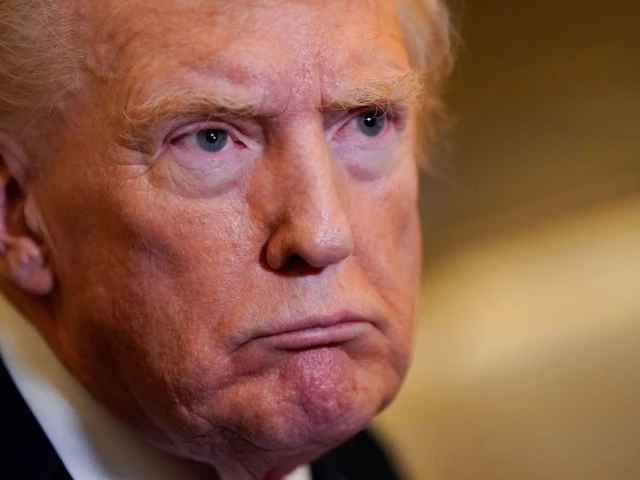Business
Trade deficit is not crisis, it’s investment in growth | The Express Tribune

Rising imports of industrial inputs signal economic revival, not decline, as Pakistan embarks on tariff reform
ISLAMABAD:
Each month, when the Pakistan Bureau of Statistics (PBS) releases its trade figures, one number grabs headlines: the trade deficit or the gap between imports and exports. The latest data, showing a 38% increase in the first four months of the fiscal year, was no exception. Predictably, critics of trade reform were quick to argue that Pakistan’s import liberalisation is driving the country towards economic ruin.
Some even call the tariff reform a “suicide mission.” Their solution is predictable: return to the old playbook of regulatory and additional duties. But this strategy has been tried repeatedly over the last 17 years, and each time it worsened the very problems it aimed to solve, leading to stagnant growth, deeper poverty, and declining exports.
What this debate often ignores is a simple question: what kinds of imports are rising? About 85% of Pakistan’s imports consist of petroleum, chemicals, machinery, textile industry raw materials, metals, and essential food products such as edible oils, tea, and lentils. These are not luxury items; they are critical inputs for production, energy, and food security. Rising imports of this kind suggest that industries are reviving and consumer demand is strengthening, both signs of economic activity.
Despite the widening trade gap, the deficit has not drained foreign exchange reserves or worsened the current account. Even with recent loan repayments of $400 million, Pakistan’s foreign exchange reserves remain stable at around $14.5 billion. If imports are building productive capacity, the resulting trade deficit becomes an investment in future growth. As industries modernise and productivity improves, exports catch up, just as they have in nearly every fast-developing economy.
Some critics question why exports have not risen despite tariff cuts. But the reform process only began in July 2025. Until the last fiscal year, Pakistan was still raising tariffs. In July 2024, regulatory duties were increased on over 600 items and additional customs duties on more than 2,000. The current tariff rationalisation plan spans five years, aimed at correcting 17 years of flawed policy. Expecting exports to surge within months is unrealistic – structural reforms take time to bear fruit.
Economic history supports this view, and India’s experience offers a striking example. When the country began liberalising in 1992, its imports and exports were nearly balanced at around $20 billion, with a $2 billion trade deficit. By 2024, its merchandise imports had risen to approximately $720 billion, while exports grew to $437 billion, resulting in a $283 billion trade deficit – with China accounting for half. Yet no one accuses Manmohan Singh of steering India towards economic “suicide.” On the contrary, he is praised for revitalising India’s economy after decades of stagnation.
Pakistan’s own experience is equally telling. As the economy opened in the 1990s and accelerated around 2000, both imports and exports grew rapidly. Imports of telecom equipment, machinery, and industrial materials built the foundation for modern services and infrastructure. The trade deficit widened, but instead of staying the course, Pakistan reversed reforms after 2008, slowing growth and weakening competitiveness. The result has been prolonged stagnation.
Another major argument against tariff reform has been the fear of revenue loss. Yet the numbers tell a different story. The Pakistan Institute of Development Economics (PIDE) had long projected gains instead of only minimal losses, and they were right. In the first quarter of this fiscal year, customs duty collections rose by 13%, exceeding targets even after duty cuts.
It may be too soon for firm conclusions, but both past experience and current trends suggest that lower tariffs are encouraging legal imports and improving compliance, not eroding revenue.
Pakistan now stands at a crossroads. It can continue to oscillate between protectionist fear and half-hearted reforms, or it can follow the path of countries that embraced openness to accelerate growth. Pakistan is no longer a bystander in global affairs. It is now positioned at the intersection of shifting geopolitical and economic currents.
To seize this moment, Pakistan must lower trade barriers and open its economy to investment and integration with regional and global markets. Opportunities of this scale are rare – if Pakistan lets this one pass, it may not get another for a generation.
To sum up, a trade deficit driven by productive imports is not a loss; it is an investment in the future. As global trade patterns shift and smaller economies integrate with larger blocs, Pakistan must not be left behind. For too long, powerful lobbies have distorted the tariff system through SROs and exemptions, protecting inefficiency at the cost of progress. It is time to level the field, resist rent-seeking pressures, and stay the course on reform. Pakistan’s path to prosperity lies not in retreat or isolation, but in embracing openness and claiming its rightful place in regional and global value chains.
THE WRITER IS A MEMBER OF THE STEERING COMMITTEE OVERSEEING THE IMPLEMENTATION OF THE NATIONAL TARIFF POLICY 202530. HE HAS PREVIOUSLY SERVED AS PAKISTAN’S AMBASSADOR TO THE WTO
Business
Siemens Surges Over 4% Despite Weak Q2 Results: Why Is Stock Price Rising Today?

Last Updated:
Shares of Siemens on Monday surge by over 4.3% to trade at Rs 3,218.10 apiece on the NSE despite a 7% y-o-y decline in consolidated net profit to Rs 485 crore in Q2.

Siemens Share Price.
Siemens Share Price Today: Shares of Siemens on Monday surged by over 4.3% to trade at Rs 3,218.10 apiece on the NSE despite weak Q2 results. The heavy electrical equipment maker has reported a 7 per cent year-on-year (y-o-y) decline in consolidated net profit to Rs 485 crore for the quarter ended September 30, 2025.
On the BSE, the stock traded at Rs 3,220.85 apiece as of 1:10 pm, which is nearly 4.5% higher than the previous close of Rs 3,082.95.
Siemens’ net profit (or profit after tax) had stood at Rs 523 crore in the July-September period a year ago.
However, the company saw its revenue from operations grow 16 per cent to Rs 5,171 crore during the quarter under review from Rs 4,457 crore in the year- ago period.
Siemens MD and CEO Sunil Mathur said, “We delivered a robust performance this quarter, with a surge in revenue, driven by strong performance in our mobility and smart infrastructure businesses while digital Industries volumes were impacted due to a lower reach in the order backlog from the previous year and muted private sector capex.”
He added that the profit was impacted by a one-time gain of Rs 69 crore from the sale of property in Q4 FY 2024. On August 8, 2025, the board approved changing the company’s financial year from October-September to April-March.
The current financial year is changed to October 1, 2024-March 31, 2026 (18 months). Thereafter, the financial year will be April 1 to March 31, every year.
What Brokerages Say
JM Financials in its note said Siemens’ revenue exceeded its estimates by 8%. However, its EBITDA beat was smaller at 5% on demerger-linked costs. PAT beat was a modest 2% on higher tax and lower other income. Order inflows continue to be robust relative to peer ABB India at 10% though missed our estimate by 5%.
“We resume with ADD as we value the stock at similar multiples to ABB at 50x P/E Sep-27 as Digital Industries (DI) margin challenge still persist. We note change on FY end to March end vs Sep earlier makes direct comparison superfluous for FY26E numbers,” JM Financial said.
Motilal Oswal has maintained its ‘Neutral’ stance on the stock, saying it wants to see a more broad-based ramp-up in scale before turning more positive. The firm noted that its current forecasts already bake in margin gains across divisions. It expects the smart infrastructure vertical to continue delivering strong growth, with a gradual pickup likely in the digital industries and mobility businesses as well.
Antique Stock Broking highlighted how Siemens has consistently reshaped its business model, moving away from being a pure industrial products player to becoming a technology-driven company aligned with investment themes across industry, infrastructure and transportation. The brokerage believes Siemens is well-positioned to ride the country’s ongoing capital expenditure cycle.

Haris is Deputy News Editor (Business) at news18.com. He writes on various issues related to personal finance, markets, economy and companies. Having over a decade of experience in financial journalism, Haris h…Read More
Haris is Deputy News Editor (Business) at news18.com. He writes on various issues related to personal finance, markets, economy and companies. Having over a decade of experience in financial journalism, Haris h… Read More
November 17, 2025, 13:18 IST
Read More
Business
Japan tourism and retail stocks slide after China row

Japanese tourism and retail stocks fell on Monday after China warned its citizens not to travel to the country as Tokyo and Beijing remain locked in a row over Taiwan.
Japan’s Prime Minister Sanae Takaichi, who has been a vocal critic of China and its military activities in the region, suggested this month Tokyo could take military action if Beijing attacked Taiwan.
Shares in cosmetics company Shiseido plunged nearly 10% while department store chain Takashimaya and the owner of global fashion chain Uniqlo fell more than 5% in early trading.
China has consistently ranked among the top sources of tourists visiting Japan.
The share price falls came after the dispute between Beijing and Tokyo has deepened in recent days.
On Sunday, the Chinese government urged its citizens to reconsider studying in Japan, citing risks to their safety and a rise in crimes targeting Chinese people.
China’s Education Ministry also told students already based in Japan to closely monitor the security situation.
Last year, more than 100,000 Chinese students were enrolled in educational institutions in Japan, according to a Japanese government survey.
Also over the weekend, Chinese airlines – including China Southern Airlines, China Eastern Airlines, and Air China – offered refunds for flights to Japan.
Takaichi said in the Japanese parliament on 7 November: “If there are battleships and the use of force, no matter how you think about it, it could constitute a survival-threatening situation.”
A “survival-threatening situation” is a legal term under Japan’s 2015 security law, referring to when an armed attack on its allies presents an existential threat to Tokyo.
In such a situation, Japan’s self-defence forces can be called upon to respond to the threat.
Taiwan lies around 100km (60 miles) south of the closest Japanese island.
Beijing sees Taiwan as a breakaway province that will, eventually, be part of the country, and has not ruled out the use of force to achieve this.
But many Taiwanese consider themselves to be part of a separate nation – although most are in favour of maintaining the status quo where Taiwan neither declares independence from China nor unites with it.
Business
How my on-air ‘brain fog’ moment sparked a big debate

Zoe KleinmanTechnology editor
 BBC
BBCWhen I rather nervously shared a personal post about dealing with brain fog at work on the social network LinkedIn last week, I had no idea that it would have such an enormous impact.
It’s been viewed hundreds of thousands of times. Women have stopped me on the street to talk to me about it.
I’ve been overwhelmed by hundreds of messages from people sharing support and their own experiences of it.
Usually I cover technology news. But given the response, it felt important to talk about this as well.
“Brain fog” isn’t a medical term. But you may well know exactly what I’m talking about.
That moment when you suddenly can’t remember the word for something really obvious, or you’re mid-sentence and you lose your train of thought. It’s infuriating, and it can be embarrassing.
Where was I?
Ah yes, for me, as a woman in my 40s, it’s coincided with perimenopause – the stage in my life where my hormone levels are changing. There can of course be other neurological conditions for which brain fog can be a symptom too.
If you’re in a job where public speaking is part of what you do, it can be particularly terrifying.
“I’ve spent 30 years being professionally articulate,” wrote Janet Edgecombe, an internal communications expert.
“All of a sudden I’m forgetting the words for basic things. ‘That grey thing in the thingy that we cook chicken on’. My husband replies ‘oh, the baking tray in the oven’. Hmm. ‘Yeah, that thing’.”
 Getty Images
Getty ImagesI also heard from teachers, start-up founders having to present pitches for money to investors, women running workshops, delivering speeches – and fellow journalists trying to report live on-air, like me. But of course it can also hit mid-conversation, in a more intimate but no less frustrating way.
My post was about my decision to hold a page of notes on the BBC News at Ten. A story had broken late in the afternoon, following an already busy day, and by the time we reached 10pm, I knew I was getting tired and I could feel the brain fog.
I was going to talk about an outage that was affecting dozens of websites and apps, and I planned to use the technical jargon for it, as given by the company affected, and then explain what it actually meant.
But I just couldn’t get the phrase to stick in my head and I knew that without it, I wouldn’t manage the rest of what I needed to say.
I was reporting live from Glasgow. Like many of my professional peers, I do not have, and I’ve never had, autocue. And so, for the first time, I decided at the last minute to hold a page of notes with the offending phrase on it.
It felt to me at the time like an admission of failure. I have been trained never to use notes – unless there’s a specific legal reason why the wording of a statement, for example, has to be precise, or there are a lot of figures to remember.
Even then, I have prided myself on having a good enough short-term memory to get me through.
Using notes is discouraged in the world of public speaking. They are not permitted to anyone giving a 12-minute TED talk. The speaker is expected to memorise their speech.
Looking down the barrel of the camera and clutching that paper, live on TV, felt tough.
But around 10% of women report leaving their jobs due to menopause symptoms, according to the Fawcett Society. And research by insurance firm Royal London found that half of women going through it have considered giving up work. I don’t want to do that – and so I stuck with my solution.
To my intense relief, some people said they thought my paper looked authoritative, that they just assumed it was a breaking story and the page contained fresh information. Others asked why I hadn’t used a device instead – I suppose I thought the potential of having to fumble with a screen would feel even worse.
“Let’s start a movement: Hold your notes,” wrote Elisheva Marcus, vice president of communications at the venture capitalist firm Earlybird.
And so, the hashtag holdthenotes was born.
“Have you ever checked your testosterone levels?” menopause expert Dr Louise Newson asked me.
She says testosterone – despite its reputation for being a male hormone, and its association with sex drive and libido, is actually an essential brain chemical for both men and women, and levels fall in both genders. One of the results is brain fog.
“It’s like you’ve been drugged,” she says. “It’s really scary, a lot of people worry they’ve got dementia.”
“I remember when I had my levels done 10 years ago, and I was like ‘Thank God, at least I know why I’m feeling so awful’.”
She adds that there are studies dating back to the 1940s indicating that testosterone can improve brain function and wellbeing in women as well as men, but the randomised control studies, where participants are given either a placebo or the product itself in order to see whether it really works, have only focused on improvements to libido.
NHS-prescribed Hormone Replacement Therapy, or HRT, is traditionally a combination of oestrogen and progesterone. Testosterone is not routinely included.
Instead doctors can separately prescribe testosterone to female patients, at lower doses than given to men.
 Getty Images
Getty ImagesThere are also a myriad of menopause supplements which claim to ease symptoms including brain fog. Estimates vary but it’s a multi-billion dollar industry and its booming.
Women spend an average of £147 per year on supplements to try to alleviate their menopause symptoms, according to a survey earlier this year by the nutrition news website NutraIngredients.
“They might help a bit,” says Dr Newson.
“I do yoga every day, and that helps my brain become clear and focused, but I have a hormone deficiency, I can’t eat my way out of it, or exercise my way out of it.
“A lot of women spend a fortune trying to improve symptoms of a hormone deficiency with something else.”
Dr Joshua Chen is part of the Harvard Medical School-Massachusetts General Hospital Photobiomodulation Research Group. The team is looking at how frequencies of red light can change the mitochondria inside the brain to improve focus.
He describes it as “like a face mask, but for the brain”. It can also, he says, be applied to the Vagus nerve on the neck to reduce stress.
He has founded a company called Niraxx which markets a headband called a neuro espresso, which is designed to be worn for up to 20 minutes a day. He claims the results are instant. It has to be plugged in – there are no batteries in the device for safety reasons.
 Niraxx
NiraxxAngela Marsh is a registered nurse and a menopause coach. She says her clients often describe brain fog as feeling like they are “living life in soft focus”.
“I don’t think brain fog is taken seriously enough at all,” she says.
“Many women feel deeply unsettled by the changes they experience. They think there’s something wrong with them or they’re ‘losing it’ when in fact there’s a clear biological reason.”
As for me – well, I’ve booked a blood test to check my hormone levels. I’m going to try some red-light therapy. And you are probably going to see me holding notes a bit more often.
-

 Entertainment1 week ago
Entertainment1 week agoChina unveils£5.4 bn Fujian, its most advanced aircraft carrier yet
-

 Tech7 days ago
Tech7 days agoFrom waste to asset: Turning ethanol production CO₂ into jet fuel
-

 Tech2 days ago
Tech2 days agoNew carbon capture method uses water and pressure to remove CO₂ from emissions at half current costs
-

 Sports1 day ago
Sports1 day agoTexas A&M officer scolds South Carolina wide receiver after touchdown; department speaks out
-

 Politics3 days ago
Politics3 days agoBritish-Pakistani honoured for transforming UK halal meat industry
-
Sports1 week ago
College football winners and losers: The catch of the year saves Indiana
-

 Business1 week ago
Business1 week agoMore than 1,000 flights cancelled as US air traffic cuts enter second day
-
Sports1 week ago
The next Tom Brady? No, Drake Maye is a different breed.


1724844288-0/BeFunky-collage]_______-(8)1724844288-0-640x480.webp)










